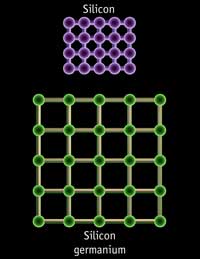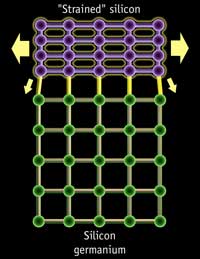Intel's Pentium 4 E: Prescott Arrives with Luggage
by Anand Lal Shimpi & Derek Wilson on February 1, 2004 3:06 PM EST- Posted in
- CPUs
Something to be proud about
Intel is particularly proud of their 90nm process as it incorporates new technologies that are a first in desktop microprocessors. The biggest of them all is the use of Strained Silicon, which we explained back in August of 2002 when Intel first announced that they would use the technology:
Strained Silicon works by effectively stretching the silicon in the channel region of the transistor. The engineers at Intel's fab facilities don't sit there and pull on both ends of the silicon in order to get it to stretch; rather they place the silicon on top of a substrate whose atoms are already spaced further apart than the silicon that needs to be stretched. The result of this is that the silicon atoms on top of the substrate will stretch to match the spacing of the substrate below, thus "stretching" the silicon in the channel.
 |
 |
|
Silicon is "strained" by using a substrate of more widely spaced atoms below the silicon channel of a transistor. (Images courtesy of IBM) |
|
With more well spaced silicon atoms, electrons can now flow with less resistance in the channel meaning that more current can flow through the channel when needed. The end result is a 10 - 20% increase in drive current, or the current flowing through the channel of the transistor.
![]()
Intel claims that their Strained Silicon technology has no real downsides (unlike competing solutions) other than its 2% increase in manufacturing costs. Intel's 90nm process will make use of Strained Silicon technology to improve the performance of their 90nm transistors.
Intel’s 90nm process does not make use of Silicon on Insulator and according to their manufacturing roadmaps it never will. Intel will introduce SOI on their 65nm process in 2005.

Prescott's 112 mm^2 die
Prescott is Intel’s first desktop microprocessor to have 7 metal layers, 2 fewer layers than AMD’s Athlon 64. Intel had to add the 7th layer simply because of the skyrocketing transistor count of Prescott (125 million vs. Northwood’s 55 million). It’s not normally desirable to increase the number of metal layers you have on a chip as it increases manufacturing complexity and cost, but in some cases it is unavoidable. The fact that Intel was able to keep the number of metal layers down to 7 is quite impressive, as AMD had to resort to 9 layers dating back to the introduction of their Thoroughbred-B Athlon XP core to keep clock speeds high.
|
CPU Core Comparison |
|||||
| Code Name |
Willamette |
Northwood |
Northwood EE |
Prescott |
AMD Athlon 64 |
| Manufacturing Process |
0.18-micron |
0.13-micron |
0.13-micron |
90 nm |
0.13-micron |
| Die Size |
217 mm^2 |
131 mm^2 |
237 mm^2 |
112 mm^2 |
193 mm^2 |
| Metal Layers |
6 |
6 |
6 |
7 |
9 |
| Transistor Count |
42 Million |
55 Million |
178 Million |
125 Million |
105.9 Million |
| Voltage |
1.750V |
1.50V |
1.50V |
1.385V |
1.50V |
| Clock Speeds |
1.3 - 2.0GHz |
1.6 - 3.4GHz |
3.2 - 3.4GHz |
2.8 - 4GHz+ |
2.0GHz+ |
| L1 Instruction/Trace Cache | 12K µops |
12K µops |
12K µops |
12K µops |
64KB |
| L1 Data Cache | 8KB |
8KB |
8KB |
16KB |
64KB |
| L2 Cache | 256KB |
512KB |
512KB |
1MB |
1MB |
| L3 Cache | N/A |
N/A |
2MB |
N/A |
N/A |










104 Comments
View All Comments
mattsaccount - Sunday, February 1, 2004 - link
From the HardOCP review: "Certainly moving to watercooling helped us out a great deal. In fact it is hard for us to recommend buying a Prescott and cooling it any other way."eBauer - Sunday, February 1, 2004 - link
I am curious as to why the UT2k3 botmatch scores dropped on all CPU's... Different map?Pumpkinierre - Sunday, February 1, 2004 - link
Sorry errata on #20 that was 3.0 Northood result is out of kilter with other cpus in dtata analysis sysmark 2004.Pumpkinierre - Sunday, February 1, 2004 - link
JFK,Vietnam,Nixon,Monica,Bush/Gore,Iraq and now this! - what is going on with the leader of the free world.I hope it overclocks well- that's all that's going for it. Maybe Intel should rethink their multiplier locked policy. AMD must get in there and profit. I still dont understand why the caches are running at half the latency as Northood if they are the same speed and structure? Is it as a result of a doubling in size for the same associativity?Good article- needs re-rereading after digestion. Last chart in Sysmark2004 (data analysis) has 3.0 Prescott totally outperformed by 2.8 Prescott and all other cpus. Look like a benchmark/typing glitch.
yak8998 - Sunday, February 1, 2004 - link
first the error:pg 9 -
The LDDQU instruction is one Intel is particularly proud of as it helps accelerate video encoding and it is implemented in the DivX 5.1.1 codec. More information on how it is used can be found in Intel’s developer documentation here.
No link?
===
"What's the power consumption like on these new bad boys?
Is anything less than a quality 450watt PSU gonna be generally *NOT* recommended?? "
I'm going to guess a clean running ~350W or so should suffice for a regular system, but I'm not positive with these monster gfx cards out rite now...
"Any of you know what the cache size on the EE's will be?"
If your talking about the Northwood (the p4c's are still considered northwoods, no?), its 1mb I believe.
(still finishing the article. man i love these in-depth technical articles)
Tiorapatea - Sunday, February 1, 2004 - link
I agree, some info on power consumption please.Thanks for the article, by the way.
I guess we'll have to wait and see how Prescott ramps in speed versus 90nm A64.
AgaBooga - Sunday, February 1, 2004 - link
Much better than the P4's origional launch...All I want to know now is what AMD is going to do soon... They'll probably counteract Prescott with high clock speeds but when and by how much is what matters.
Any of you know what the cache size on the EE's will be?
Also, the final CPU's based on Northwood are kind of like a car with the ratio curves or whatever they're called, but basically after a point of revving, going any higher doesn't give you as much of an increase in speed as it would at a lower rpm increasing the same amount.
Cygni - Sunday, February 1, 2004 - link
AMD's roadmap shows a 4000+ Athlon64 by the end of the year... which is the same as Intel's. They are aware, im sure.Stlr22 - Sunday, February 1, 2004 - link
What's the power consumption like on these new bad boys?Is anything less than a quality 450watt PSU gonna be generally *NOT* recommended??
HammerFan - Sunday, February 1, 2004 - link
Things are gonna get hairy in '04 and '05!!! My take is that AMD nees to get their marketing up-to-spec or the high-clocked prescotts are gonna run the show.I have a question for Derek and Anand: What kind of temps does the prescott run at? what type of cooler does it have? (there's nothing there to support or refute claims that the prescott is one hot potato)